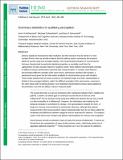Summary statistics in auditory perception
Author(s)
Schemitsch, Michael; Simoncelli, Eero P; McDermott, Josh
DownloadMcDermott_Summary statistics.pdf (2.487Mb)
OPEN_ACCESS_POLICY
Open Access Policy
Creative Commons Attribution-Noncommercial-Share Alike
Terms of use
Metadata
Show full item recordAbstract
Sensory signals are transduced at high resolution, but their structure must be stored in a more compact format. Here we provide evidence that the auditory system summarizes the temporal details of sounds using time-averaged statistics. We measured discrimination of 'sound textures' that were characterized by particular statistical properties, as normally result from the superposition of many acoustic features in auditory scenes. When listeners discriminated examples of different textures, performance improved with excerpt duration. In contrast, when listeners discriminated different examples of the same texture, performance declined with duration, a paradoxical result given that the information available for discrimination grows with duration. These results indicate that once these sounds are of moderate length, the brain's representation is limited to time-averaged statistics, which, for different examples of the same texture, converge to the same values with increasing duration. Such statistical representations produce good categorical discrimination, but limit the ability to discern temporal detail.
Date issued
2013-02Department
Massachusetts Institute of Technology. Department of Brain and Cognitive SciencesJournal
Nature Neuroscience
Publisher
Nature Publishing Group
Citation
McDermott, Josh H, Michael Schemitsch, and Eero P Simoncelli. “Summary Statistics in Auditory Perception.” Nat Neurosci 16, no. 4 (February 24, 2013): 493–498.
Version: Author's final manuscript
ISSN
1097-6256
1546-1726